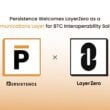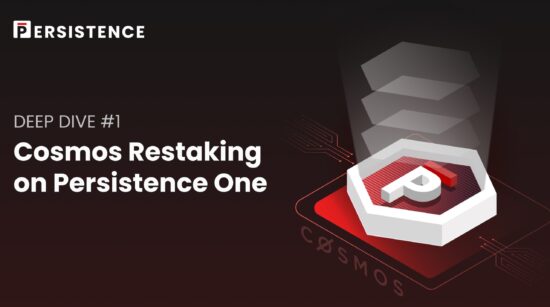In the dynamic landscape of Proof-of-Stake technology, Restaking has emerged as a groundbreaking innovation. This transformative mechanism—whereby users stake an asset in one place and then restake it somewhere else—not only fortifies the security of the PoS chains and decentralized applications (dApps) but also unlocks new avenues for participants to earn additional rewards. Pioneered by Eigen Layer on Ethereum, Restaking has rapidly gained momentum, surpassing an impressive Total Value Locked (TVL) of $7 billion, 100k+ depositors, and support for 9 Ethereum Liquid Staking Tokens (LSTs) on the Eigen Layer.
Restaking in Cosmos: Persistence One is building Restaking infrastructure in Cosmos on top of Terra’s Alliance Module that will allow users able to deposit Liquid Staked Tokens (of ATOM, TIA, DYDX, etc.) by pSTAKE, Stride, Quicksilver, and Milkyway onto Persistence One. This enables them to restake their assets and secure additional chains, starting with the Persistence Core-1 chain, while earning additional rewards.
In our previous blog, we introduced Restaking on Persistence One and its positive impact on the Cosmos ecosystem. This blog post will delve deeper into the infrastructure of Restaking on the Persistence chain, emphasizing the role of Alliance Module–a pioneering Interchain solution that leverages interchain staking to strengthen the economic viability of blockchain economies and create additional opportunities for staking yield. We will compare the need for Restaking in Ethereum vs Cosmos and explore the technical implementation of the alliance module while also highlighting its potential in an ecosystem where blockchain networks are progressively reducing inflation rates and seeking sustainable long-term yield, all without compromising on the network security.
P.S.: This is Deep Dive #1 of our Restaking blog series.
Restaking in Ethereum vs Cosmos
Ethereum and Cosmos represent distinct blockchain ecosystems with divergent objectives. Ethereum, renowned for its smart contract capabilities, operates as a Proof-of-Stake (PoS) chain where liquid staking is prevalent and significantly easier. The Total Value Locked (TVL) in Ethereum Liquid Staking Tokens (LSTs) surpassed $40 billion, with 25% of the total ETH liquid staked. Its derivative counterpart, Restaking, has taken the crypto industry by storm and has grown to a $6B+ market in a matter of months. The adoption of liquid staking and Restaking have seen a clear product market fit in the Ethereum Ecosystem.
In contrast, Cosmos employs a Delegated Proof of Stake (dPoS) mechanism, providing users with straightforward access to native staking. Despite Cosmos’ offerings of interoperability and technological superiority, a notable portion of stakers tends to be risk-averse, opting for traditional staking over liquid staking.
In the historical context of Cosmos, staking has evolved, particularly in relation to the token inflation rates. Previously, higher inflation rates and lack of Cosmos DeFi made staking a more lucrative avenue for yield. However, over time inflation has decreased, resulting in diminished staking yield opportunities. Consequently, the lower staking ratio poses challenges to the economic security of the chain.
The EigenLayer serves as an exemplary model for the concept of Proof of Restaking, demonstrating how Restaking can be employed to bolster crypto-economic security and increase sustainable long-term yield.
In the Cosmos ecosystem, Persistence One is committed to constructing a robust infrastructure designed to enhance chain security. This innovative framework will not only facilitate the provision of security-as-a-service but also ensure that stakers are rewarded with diversified yield.
To build a Restaking infrastructure, Persistence One will leverage Terra’s Alliance Module at the base layer and build other functionalities on top of it. Additionally, the potential for emerging opportunities in the Liquid Restaking Token Finance (LRTfi) space further enriches the staking experience.
Leveraging Terra’s Alliance Module
Alliance is an open-source Cosmos SDK module built by Terraform Labs that enables blockchains to form mutually beneficial relationships—similar to trade agreements between countries—by leveraging interchain staking. This innovative solution expands the scope of assets eligible for staking on an IBC-enabled chain, introducing a diverse range of assets known as Alliance assets (described in the next section). These Alliance assets encompass any token compatible with the Cosmos SDK bank module, which allows for minting, burning or sending coins.
Alliance facilitates the staking of assets from one blockchain onto another (restaking), creating a mutually beneficial economic partnership through the mechanism of interchain staking. Stakeholders who choose to participate by staking Alliance assets on an IBC-enabled chain stand to gain not only a share of the staking rewards generated by the chain, but also receive rewards from the underlying Alliance assets.
As an example, a smaller Cosmos chain might form an Alliance with a larger chain, enabling users of the larger chain to stake their LSTs on the smaller one to earn staking rewards. In return, a portion of the larger chain’s LSTs can be redistributed to the smaller chain’s stakers. Stakers of the smaller blockchain’s token now earn rewards not just in the smaller chain’s token, but also in the uncorrelated, more stable, and trusted token of the established chain—this strengthens the economic viability of the smaller chain’s token and ecosystem. In addition, as the larger chain’s LSTs are staked on the smaller chain, the cost of corruption (security) of the smaller chain improves and increases.
This dual-reward system enhances the incentive structure and provides a more secure and interconnected ecosystem for IBC-enabled chains.
Alliance Assets
An Alliance asset can be any asset compatible with the bank module, including Liquid Staking Tokens (LSTs), Liquidity Pool (LP) tokens, stablecoins, and other Cosmos assets. Once the Alliance module has been integrated into Persistence One, Alliance assets can be transferred to the Persistence chain via IBC and staked using the Alliance module. Once on the Persistence chain, Alliance assets adhere to the same operational rules as native assets, such as XPRT for Persistence. This includes standard processes like staking, unstaking, redelegation, and a 21-day unbonding period. For simplicity,
A user could stake on pSTAKE or any other liquid staking provider → Deposit (and lock) their Alliance asset LSTs on the Persistence chain for a 21-day unbonding period -> and earn staking rewards from the underlying LST + XPRT from Persistence One.
The integration of Alliance assets into the Persistence ecosystem requires the successful passage of a governance proposal, a crucial step in securing and enabling the asset on the Persistence chain.
Note: CW20 tokens are not currently supported within the Alliance Module, and Persistence One will be making modifications to enable it on the chain.
Alliance Staking Rewards
The rewards for an Alliance asset are determined by its Reward Weight, a parameter set through governance for each asset. The reward weight is a parameter set via governance for each Alliance asset and determines the portion of the total chain rewards the Alliance stakers of that asset will receive. As the native staking token on Persistence One, XPRT has a Reward Weight of 1.
Consider a scenario where Persistence has two Alliance assets, stkATOM and stTIA, with reward weights of 0.4 and 0.2, respectively. The distribution of XPRT staking rewards would be as follows:
Take Rate
In addition to the intrinsic rewards mentioned earlier, the Alliance module introduces a unique third reward mechanism known as the Take Rate. This annualized tax is specific to each Alliance asset and is periodically applied to staked assets within the Alliance. The resulting proceeds from the Take Rate are then distributed among all chain token stakers (in the case of Alliance assets staked on Persistence One, this includes all XPRT and Alliance asset stakers). Notably, Take Rate rewards are denominated in the Alliance asset from which they originated. This innovative feature not only provides additional incentives but also contributes to diversification within a staker’s portfolio, thereby fortifying their position against market volatility and fostering exploration across different blockchain networks.
For instance, consider staking stkATOM as an Alliance asset on the Persistence chain. The Take Rate proceeds are subsequently shared among all stakers on the Persistence chain, effectively exposing the chain to the value of stkATOM. And the Alliance asset stakers (stkATOM stakers) will receive staking rewards on the Persistence chain in the form of XPRT. This not only diversifies their wallet but also introduces exposure to a new asset.
With the Restaking module enabled, reward distribution would be as follows:
Alliance Module Deep Dive
To retain the normal functionality of the default staking module in the Cosmos SDK, the Alliance module does not stake Alliance assets directly to validators. Instead, the module tracks all Alliance delegation balances and mints the proportional amount of native tokens.
For example, users may restake LSTs like stkATOM and stTIA on Persistence One, but the Alliance module on the Persistence chain will lock these assets and mint the native token, XPRT, for delegation purposes. As a result, the Alliance module account becomes the technical owner of these restaked LSTs, and the XPRT tokens are staked to validators on behalf of the delegators.
Whenever a staking action such as staking, unstaking, or redelegation occurs, the Alliance module mints or burns the required number of native tokens to maintain the correct reward weight proportions for each restaked asset through a process called rebalancing. It is important to note that even if the supply of the restaked assets is larger than the one of the native asset, it can never have more reward power than what is specified by its reward weights.
The amount of the native asset staked with validators for each Alliance asset is determined by the reward power of the Alliance asset relative to that of the native asset, which is always set to one. In the consensus mechanism, one staked native coin is equal to one vote.
If an Alliance asset has a reward weight of 1, its total reward power will be equal to the number of staked native coins, regardless of the supply of the Alliance asset. Similarly, if an Alliance asset has a reward weight of 0.5, its total reward power will be half the number of staked native coins, irrespective of the Alliance asset’s supply. Refer below as an example:
Slashing and Take Rate Management
In an ecosystem like Cosmos, managing the allocation and redistribution of staked coins can be complex, especially when it comes to slashing (penalizing validators for misbehaviour) and applying Take Rate deductions (a tax taken from staked Alliance assets)). To simplify this process and reduce the computational cost, the Alliance module introduces the concept of ‘Shares’.
Shares represent the proportions of the total staked assets in a validator’s pool rather than tracking individual coin balances for each account. This approach is similar to how stocks work in a company, where owning shares represents a portion of the company’s value.
Here is how it works:
Conversion between coins and shares: When coins are staked or unstaked, they are converted to and from shares using a specific formula. New shares equal new coins multiplied by the ratio of the total validator shares to total coins. This formula maintains the proportionate relationship between the total coins and the total shares.
Applying Take Rate deductions: When deductions are made (e.g. for fees), only the total number of coins in the validators’ pool needs to be updated. The shares remain unchanged, but since the total pool of coins has decreased, each share now represents a smaller amount of coins. This reduction is applied proportionally across all delegations.
Slashing: When a validator is penalised due to malicious behaviour, their shares are reduced instead of directly slashing their coin balance. This means the offending validator will now claim a smaller portion of the total coin pool. Consequently, the remaining “good” validators will receive a proportional increase in their share of the total pool.
Calculating staked coins for a delegator: To determine how many coins a delegator has staked, a two-step formula is used:
- First, calculate the total coins owned by the validator by multiplying the total amount of coins in the pool by the ratio of the validators’ shares to the total shares.
- Then, determine the delegators’ share of coins by multiplying their delegation shares by the total amount of coins owned by the validator, divided by the total amount of validator shares.
By using shares, the Alliance module system efficiently manages the redistribution of staked coins without the need for constant updates to individual account balances, making the staking process more scalable and cost-effective.
Governance with Alliance
While delegators of Alliance assets have the opportunity to earn a share of rewards, it’s important to note that they do not possess voting rights for governance proposals using their staked Alliance assets. The reason lies in the ownership structure, where the underlying staked XPRT is held by the Alliance module account rather than being directly owned by the delegators themselves. Consequently, the privilege of participating in governance voting is exclusive to XPRT delegators, as they have a direct ownership stake in XPRT and are eligible to exercise voting rights.
Key Takeaways
📈 Evolution of Staking Models: Restaking in Cosmos by Persistence One will redefine the Proof-of-Stake model, evolving it into a Proof-of-Restake concept, where XPRT staking rewards play a pivotal role in enhancing the chain security while simultaneously incentivizing the liquid (re)staking economy on Persistence One.
🤝🏼 Win-Win for all: LSTs can be restaked on Persistence One to increase the chain’s economic security and earn restaking yield from XPRT staking rewards. XPRT stakers, in turn, receive additional rewards in the form of restaked assets, which are subject to a Take Rate (tax). Validators enjoy the advantage of not needing major additional infrastructure and earning more yields in different assets.
🛠️ Restaking infrastructure: Persistence One will leverage Terra’s Alliance Module at the base layer and build other functionalities on top of it. Additionally, the potential for emerging opportunities in the Liquid Restaking Token Finance (LRTfi) space further enriches the staking experience.
Cosmonauts! Be prepared to usher in the era of Restaking, and stay tuned for more deep dives on this concept.
Alliance Module Source and Credits: https://docs.alliance.money/overview/





